System Dynamics Simulation for Energy Efficiency in Buildings Analysis
VerifiedAdded on 2022/08/25
|10
|2508
|46
Report
AI Summary
This report delves into the application of system dynamics modeling to analyze and improve energy efficiency in buildings, using a case study from an academic block. The study identifies key parameters affecting electricity consumption and employs the Vensim modeling tool to simulate various scenarios, such as replacing CFLs with LEDs and adjusting operational hours. The methodology involves pre-assessment, data collection, casual loop diagrams, and archetype analysis to understand the system's behavior and predict future outcomes. The report discusses the verification of results, potential use of Monte Carlo simulation, and system archetypes, concluding that the system dynamics approach offers viable options for energy efficiency, including significant reductions in energy use and costs. The study emphasizes the importance of understanding the complexities of building energy systems and the potential for tailored solutions based on specific building characteristics and geographical factors.
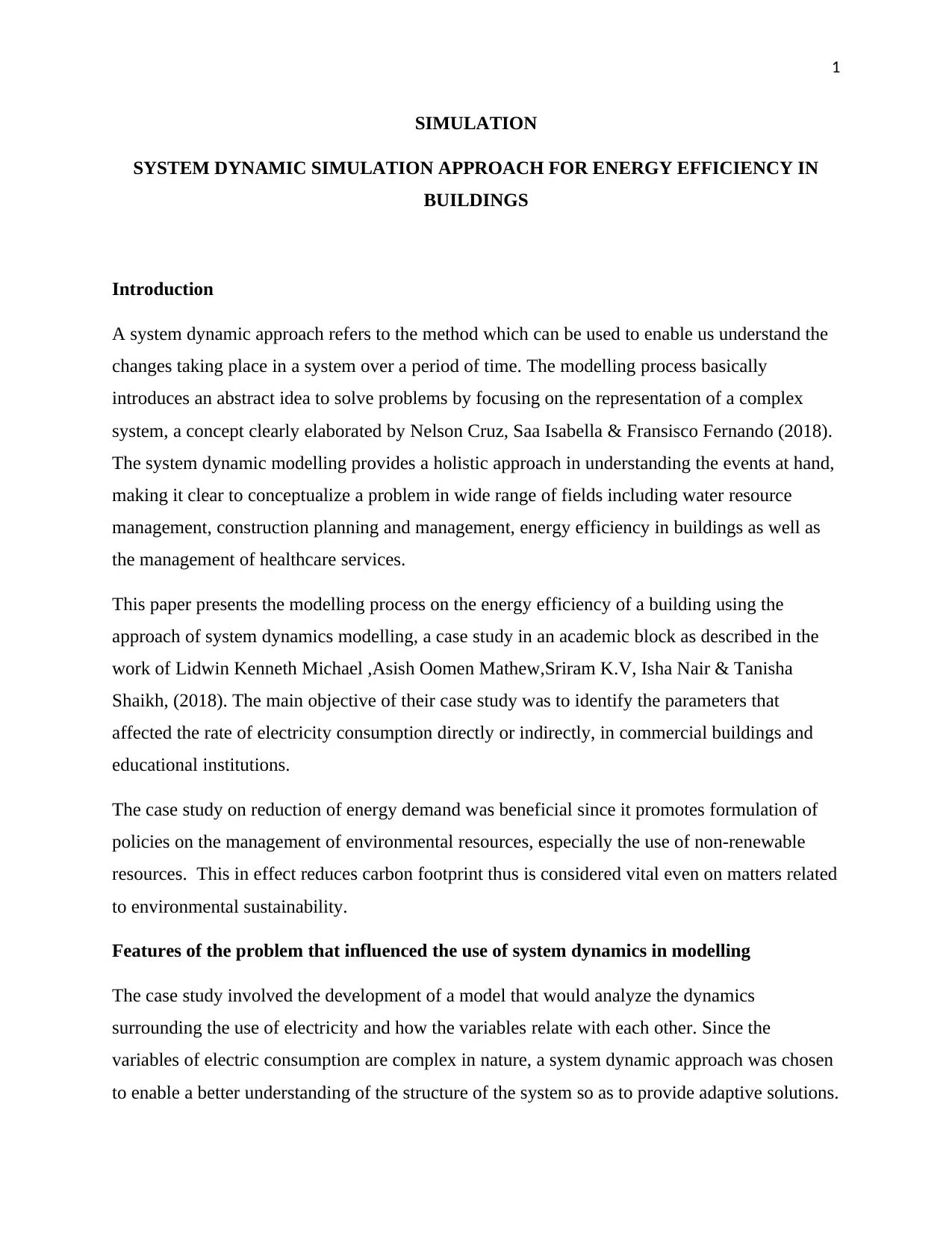
1
SIMULATION
SYSTEM DYNAMIC SIMULATION APPROACH FOR ENERGY EFFICIENCY IN
BUILDINGS
Introduction
A system dynamic approach refers to the method which can be used to enable us understand the
changes taking place in a system over a period of time. The modelling process basically
introduces an abstract idea to solve problems by focusing on the representation of a complex
system, a concept clearly elaborated by Nelson Cruz, Saa Isabella & Fransisco Fernando (2018).
The system dynamic modelling provides a holistic approach in understanding the events at hand,
making it clear to conceptualize a problem in wide range of fields including water resource
management, construction planning and management, energy efficiency in buildings as well as
the management of healthcare services.
This paper presents the modelling process on the energy efficiency of a building using the
approach of system dynamics modelling, a case study in an academic block as described in the
work of Lidwin Kenneth Michael ,Asish Oomen Mathew,Sriram K.V, Isha Nair & Tanisha
Shaikh, (2018). The main objective of their case study was to identify the parameters that
affected the rate of electricity consumption directly or indirectly, in commercial buildings and
educational institutions.
The case study on reduction of energy demand was beneficial since it promotes formulation of
policies on the management of environmental resources, especially the use of non-renewable
resources. This in effect reduces carbon footprint thus is considered vital even on matters related
to environmental sustainability.
Features of the problem that influenced the use of system dynamics in modelling
The case study involved the development of a model that would analyze the dynamics
surrounding the use of electricity and how the variables relate with each other. Since the
variables of electric consumption are complex in nature, a system dynamic approach was chosen
to enable a better understanding of the structure of the system so as to provide adaptive solutions.
SIMULATION
SYSTEM DYNAMIC SIMULATION APPROACH FOR ENERGY EFFICIENCY IN
BUILDINGS
Introduction
A system dynamic approach refers to the method which can be used to enable us understand the
changes taking place in a system over a period of time. The modelling process basically
introduces an abstract idea to solve problems by focusing on the representation of a complex
system, a concept clearly elaborated by Nelson Cruz, Saa Isabella & Fransisco Fernando (2018).
The system dynamic modelling provides a holistic approach in understanding the events at hand,
making it clear to conceptualize a problem in wide range of fields including water resource
management, construction planning and management, energy efficiency in buildings as well as
the management of healthcare services.
This paper presents the modelling process on the energy efficiency of a building using the
approach of system dynamics modelling, a case study in an academic block as described in the
work of Lidwin Kenneth Michael ,Asish Oomen Mathew,Sriram K.V, Isha Nair & Tanisha
Shaikh, (2018). The main objective of their case study was to identify the parameters that
affected the rate of electricity consumption directly or indirectly, in commercial buildings and
educational institutions.
The case study on reduction of energy demand was beneficial since it promotes formulation of
policies on the management of environmental resources, especially the use of non-renewable
resources. This in effect reduces carbon footprint thus is considered vital even on matters related
to environmental sustainability.
Features of the problem that influenced the use of system dynamics in modelling
The case study involved the development of a model that would analyze the dynamics
surrounding the use of electricity and how the variables relate with each other. Since the
variables of electric consumption are complex in nature, a system dynamic approach was chosen
to enable a better understanding of the structure of the system so as to provide adaptive solutions.
Paraphrase This Document
Need a fresh take? Get an instant paraphrase of this document with our AI Paraphraser

2
In the case study conducted by Lidwin Kenneth Michael ,Asish Oomen Mathew,Sriram K.V,
Isha Nair & Tanisha Shaikh (2018), Vensim was used as the modelling tool for system
dynamics.
Using the vensim modelling tool, it was proposed that either there should be a replacement of all
the CFLs with LEDs or to reduce the total number of working days while increasing the total
number of operating hours in the institutions. The approach worked well since it was proven that
there was a significant reduction in the energy consumption and increased savings.
System dynamics requires a combination of system thinking as well as mathematical modelling
in order to anticipate the behaviour of a system and predict future outcomes. This enables us to
make precise managerial decisions after analysis of the simulated model so as to provide
adequate intel upon which such decisions are made. Since the primary objective of system
dynamics modelling is to study a complex system and understand its behaviour, the structure of
the system should be depicted with great accuracies by the use of casualties, feedback loops,
delays and non-linearity.
JeongWook (2018) postulated that System dynamics is composed of the reinforcing loop and the
balancing loop. The reinforcing loop means there is a change in the positive direction while the
balancing loop means there is a change in the opposite direction.
Figure 1. A representation of system dynamics
In the case study conducted by Lidwin Kenneth Michael ,Asish Oomen Mathew,Sriram K.V,
Isha Nair & Tanisha Shaikh (2018), Vensim was used as the modelling tool for system
dynamics.
Using the vensim modelling tool, it was proposed that either there should be a replacement of all
the CFLs with LEDs or to reduce the total number of working days while increasing the total
number of operating hours in the institutions. The approach worked well since it was proven that
there was a significant reduction in the energy consumption and increased savings.
System dynamics requires a combination of system thinking as well as mathematical modelling
in order to anticipate the behaviour of a system and predict future outcomes. This enables us to
make precise managerial decisions after analysis of the simulated model so as to provide
adequate intel upon which such decisions are made. Since the primary objective of system
dynamics modelling is to study a complex system and understand its behaviour, the structure of
the system should be depicted with great accuracies by the use of casualties, feedback loops,
delays and non-linearity.
JeongWook (2018) postulated that System dynamics is composed of the reinforcing loop and the
balancing loop. The reinforcing loop means there is a change in the positive direction while the
balancing loop means there is a change in the opposite direction.
Figure 1. A representation of system dynamics
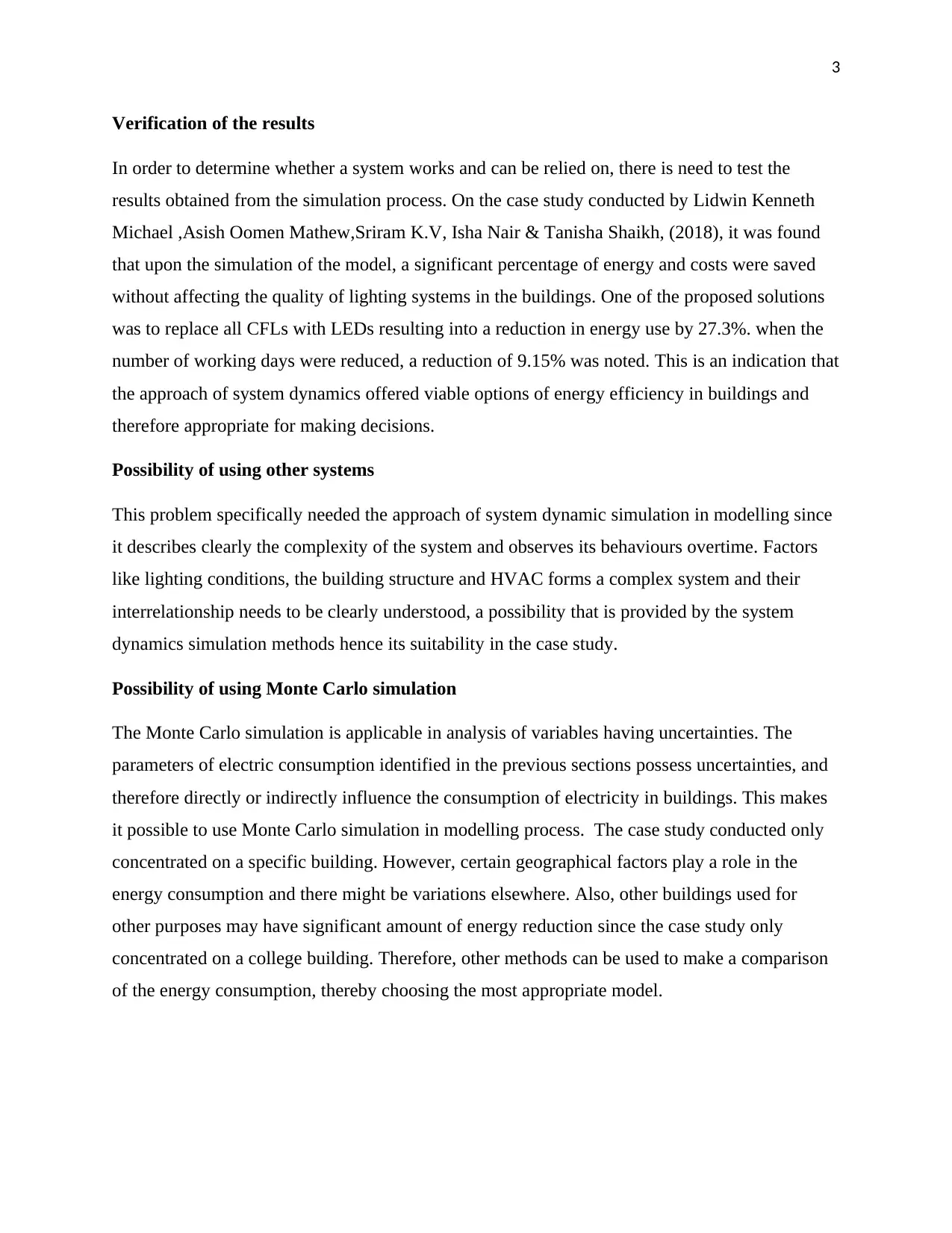
3
Verification of the results
In order to determine whether a system works and can be relied on, there is need to test the
results obtained from the simulation process. On the case study conducted by Lidwin Kenneth
Michael ,Asish Oomen Mathew,Sriram K.V, Isha Nair & Tanisha Shaikh, (2018), it was found
that upon the simulation of the model, a significant percentage of energy and costs were saved
without affecting the quality of lighting systems in the buildings. One of the proposed solutions
was to replace all CFLs with LEDs resulting into a reduction in energy use by 27.3%. when the
number of working days were reduced, a reduction of 9.15% was noted. This is an indication that
the approach of system dynamics offered viable options of energy efficiency in buildings and
therefore appropriate for making decisions.
Possibility of using other systems
This problem specifically needed the approach of system dynamic simulation in modelling since
it describes clearly the complexity of the system and observes its behaviours overtime. Factors
like lighting conditions, the building structure and HVAC forms a complex system and their
interrelationship needs to be clearly understood, a possibility that is provided by the system
dynamics simulation methods hence its suitability in the case study.
Possibility of using Monte Carlo simulation
The Monte Carlo simulation is applicable in analysis of variables having uncertainties. The
parameters of electric consumption identified in the previous sections possess uncertainties, and
therefore directly or indirectly influence the consumption of electricity in buildings. This makes
it possible to use Monte Carlo simulation in modelling process. The case study conducted only
concentrated on a specific building. However, certain geographical factors play a role in the
energy consumption and there might be variations elsewhere. Also, other buildings used for
other purposes may have significant amount of energy reduction since the case study only
concentrated on a college building. Therefore, other methods can be used to make a comparison
of the energy consumption, thereby choosing the most appropriate model.
Verification of the results
In order to determine whether a system works and can be relied on, there is need to test the
results obtained from the simulation process. On the case study conducted by Lidwin Kenneth
Michael ,Asish Oomen Mathew,Sriram K.V, Isha Nair & Tanisha Shaikh, (2018), it was found
that upon the simulation of the model, a significant percentage of energy and costs were saved
without affecting the quality of lighting systems in the buildings. One of the proposed solutions
was to replace all CFLs with LEDs resulting into a reduction in energy use by 27.3%. when the
number of working days were reduced, a reduction of 9.15% was noted. This is an indication that
the approach of system dynamics offered viable options of energy efficiency in buildings and
therefore appropriate for making decisions.
Possibility of using other systems
This problem specifically needed the approach of system dynamic simulation in modelling since
it describes clearly the complexity of the system and observes its behaviours overtime. Factors
like lighting conditions, the building structure and HVAC forms a complex system and their
interrelationship needs to be clearly understood, a possibility that is provided by the system
dynamics simulation methods hence its suitability in the case study.
Possibility of using Monte Carlo simulation
The Monte Carlo simulation is applicable in analysis of variables having uncertainties. The
parameters of electric consumption identified in the previous sections possess uncertainties, and
therefore directly or indirectly influence the consumption of electricity in buildings. This makes
it possible to use Monte Carlo simulation in modelling process. The case study conducted only
concentrated on a specific building. However, certain geographical factors play a role in the
energy consumption and there might be variations elsewhere. Also, other buildings used for
other purposes may have significant amount of energy reduction since the case study only
concentrated on a college building. Therefore, other methods can be used to make a comparison
of the energy consumption, thereby choosing the most appropriate model.
⊘ This is a preview!⊘
Do you want full access?
Subscribe today to unlock all pages.

Trusted by 1+ million students worldwide
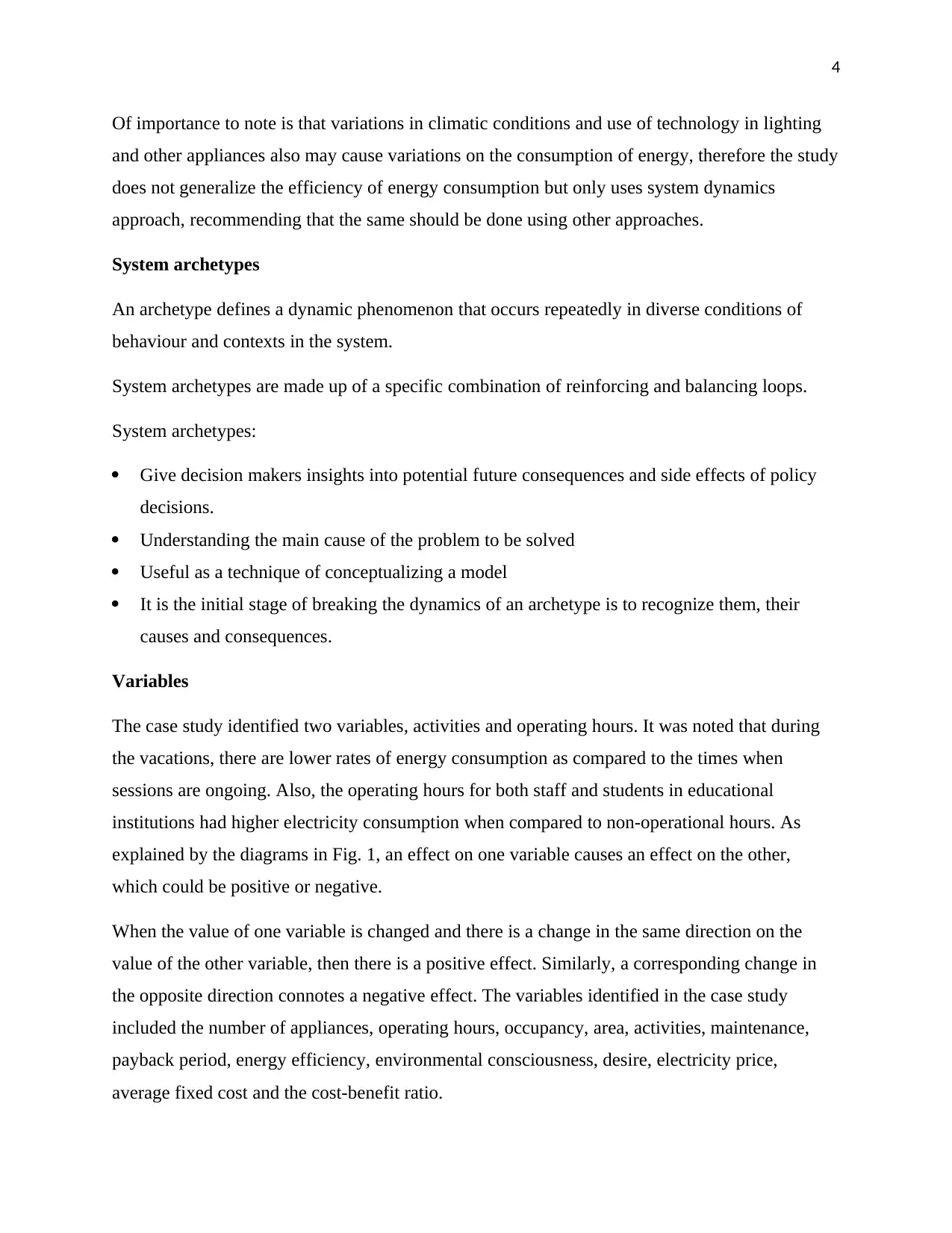
4
Of importance to note is that variations in climatic conditions and use of technology in lighting
and other appliances also may cause variations on the consumption of energy, therefore the study
does not generalize the efficiency of energy consumption but only uses system dynamics
approach, recommending that the same should be done using other approaches.
System archetypes
An archetype defines a dynamic phenomenon that occurs repeatedly in diverse conditions of
behaviour and contexts in the system.
System archetypes are made up of a specific combination of reinforcing and balancing loops.
System archetypes:
Give decision makers insights into potential future consequences and side effects of policy
decisions.
Understanding the main cause of the problem to be solved
Useful as a technique of conceptualizing a model
It is the initial stage of breaking the dynamics of an archetype is to recognize them, their
causes and consequences.
Variables
The case study identified two variables, activities and operating hours. It was noted that during
the vacations, there are lower rates of energy consumption as compared to the times when
sessions are ongoing. Also, the operating hours for both staff and students in educational
institutions had higher electricity consumption when compared to non-operational hours. As
explained by the diagrams in Fig. 1, an effect on one variable causes an effect on the other,
which could be positive or negative.
When the value of one variable is changed and there is a change in the same direction on the
value of the other variable, then there is a positive effect. Similarly, a corresponding change in
the opposite direction connotes a negative effect. The variables identified in the case study
included the number of appliances, operating hours, occupancy, area, activities, maintenance,
payback period, energy efficiency, environmental consciousness, desire, electricity price,
average fixed cost and the cost-benefit ratio.
Of importance to note is that variations in climatic conditions and use of technology in lighting
and other appliances also may cause variations on the consumption of energy, therefore the study
does not generalize the efficiency of energy consumption but only uses system dynamics
approach, recommending that the same should be done using other approaches.
System archetypes
An archetype defines a dynamic phenomenon that occurs repeatedly in diverse conditions of
behaviour and contexts in the system.
System archetypes are made up of a specific combination of reinforcing and balancing loops.
System archetypes:
Give decision makers insights into potential future consequences and side effects of policy
decisions.
Understanding the main cause of the problem to be solved
Useful as a technique of conceptualizing a model
It is the initial stage of breaking the dynamics of an archetype is to recognize them, their
causes and consequences.
Variables
The case study identified two variables, activities and operating hours. It was noted that during
the vacations, there are lower rates of energy consumption as compared to the times when
sessions are ongoing. Also, the operating hours for both staff and students in educational
institutions had higher electricity consumption when compared to non-operational hours. As
explained by the diagrams in Fig. 1, an effect on one variable causes an effect on the other,
which could be positive or negative.
When the value of one variable is changed and there is a change in the same direction on the
value of the other variable, then there is a positive effect. Similarly, a corresponding change in
the opposite direction connotes a negative effect. The variables identified in the case study
included the number of appliances, operating hours, occupancy, area, activities, maintenance,
payback period, energy efficiency, environmental consciousness, desire, electricity price,
average fixed cost and the cost-benefit ratio.
Paraphrase This Document
Need a fresh take? Get an instant paraphrase of this document with our AI Paraphraser
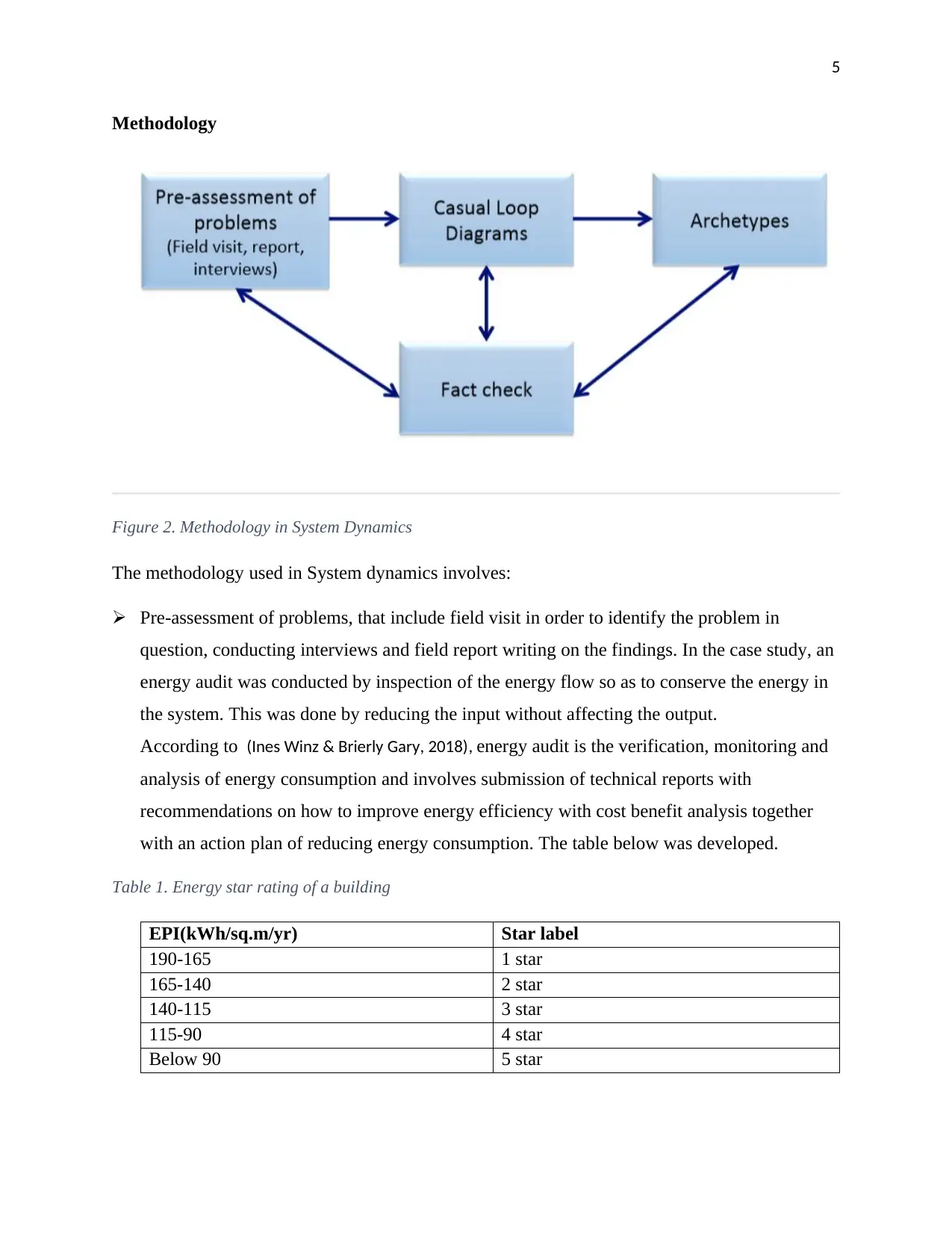
5
Methodology
Figure 2. Methodology in System Dynamics
The methodology used in System dynamics involves:
Pre-assessment of problems, that include field visit in order to identify the problem in
question, conducting interviews and field report writing on the findings. In the case study, an
energy audit was conducted by inspection of the energy flow so as to conserve the energy in
the system. This was done by reducing the input without affecting the output.
According to (Ines Winz & Brierly Gary, 2018), energy audit is the verification, monitoring and
analysis of energy consumption and involves submission of technical reports with
recommendations on how to improve energy efficiency with cost benefit analysis together
with an action plan of reducing energy consumption. The table below was developed.
Table 1. Energy star rating of a building
EPI(kWh/sq.m/yr) Star label
190-165 1 star
165-140 2 star
140-115 3 star
115-90 4 star
Below 90 5 star
Methodology
Figure 2. Methodology in System Dynamics
The methodology used in System dynamics involves:
Pre-assessment of problems, that include field visit in order to identify the problem in
question, conducting interviews and field report writing on the findings. In the case study, an
energy audit was conducted by inspection of the energy flow so as to conserve the energy in
the system. This was done by reducing the input without affecting the output.
According to (Ines Winz & Brierly Gary, 2018), energy audit is the verification, monitoring and
analysis of energy consumption and involves submission of technical reports with
recommendations on how to improve energy efficiency with cost benefit analysis together
with an action plan of reducing energy consumption. The table below was developed.
Table 1. Energy star rating of a building
EPI(kWh/sq.m/yr) Star label
190-165 1 star
165-140 2 star
140-115 3 star
115-90 4 star
Below 90 5 star
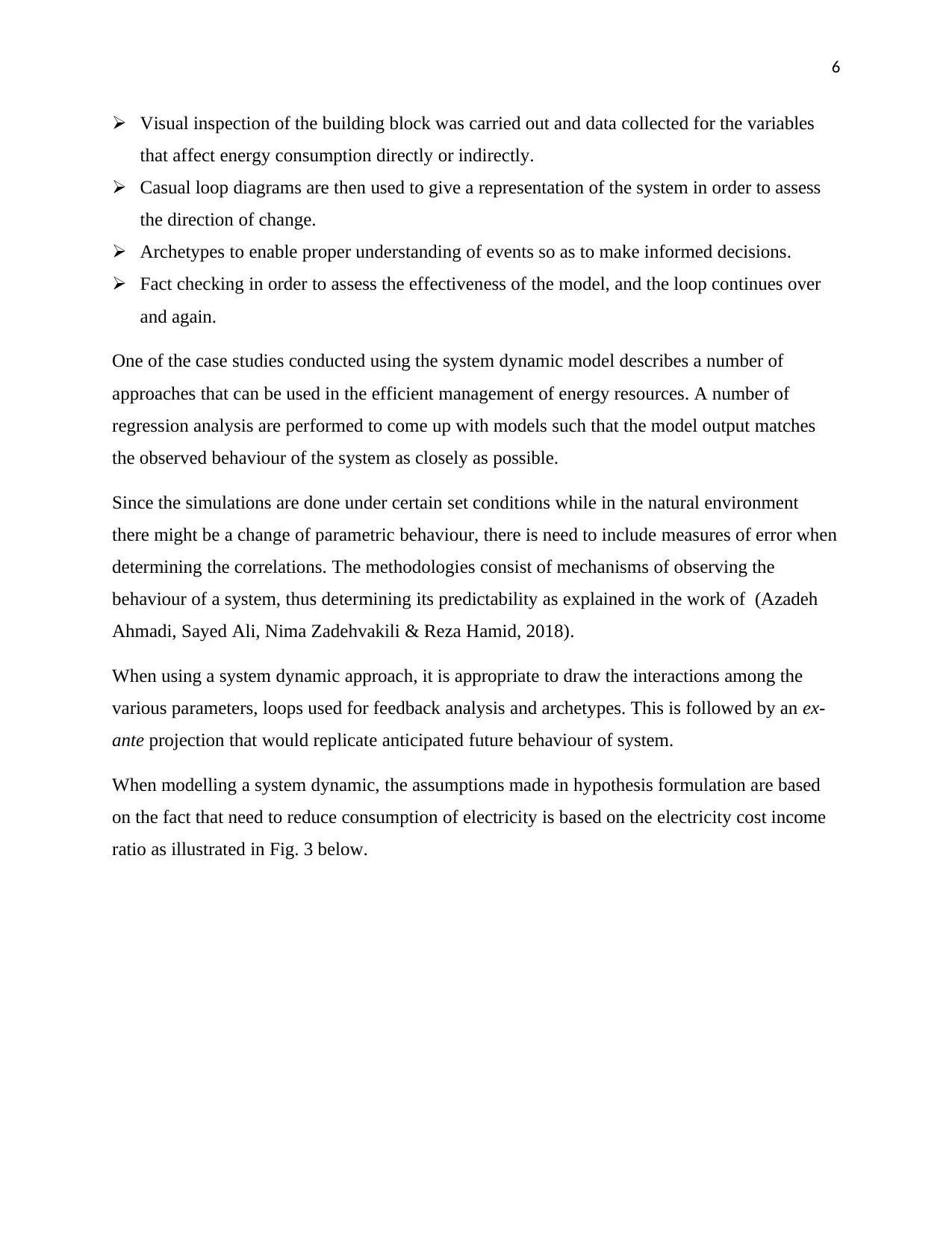
6
Visual inspection of the building block was carried out and data collected for the variables
that affect energy consumption directly or indirectly.
Casual loop diagrams are then used to give a representation of the system in order to assess
the direction of change.
Archetypes to enable proper understanding of events so as to make informed decisions.
Fact checking in order to assess the effectiveness of the model, and the loop continues over
and again.
One of the case studies conducted using the system dynamic model describes a number of
approaches that can be used in the efficient management of energy resources. A number of
regression analysis are performed to come up with models such that the model output matches
the observed behaviour of the system as closely as possible.
Since the simulations are done under certain set conditions while in the natural environment
there might be a change of parametric behaviour, there is need to include measures of error when
determining the correlations. The methodologies consist of mechanisms of observing the
behaviour of a system, thus determining its predictability as explained in the work of (Azadeh
Ahmadi, Sayed Ali, Nima Zadehvakili & Reza Hamid, 2018).
When using a system dynamic approach, it is appropriate to draw the interactions among the
various parameters, loops used for feedback analysis and archetypes. This is followed by an ex-
ante projection that would replicate anticipated future behaviour of system.
When modelling a system dynamic, the assumptions made in hypothesis formulation are based
on the fact that need to reduce consumption of electricity is based on the electricity cost income
ratio as illustrated in Fig. 3 below.
Visual inspection of the building block was carried out and data collected for the variables
that affect energy consumption directly or indirectly.
Casual loop diagrams are then used to give a representation of the system in order to assess
the direction of change.
Archetypes to enable proper understanding of events so as to make informed decisions.
Fact checking in order to assess the effectiveness of the model, and the loop continues over
and again.
One of the case studies conducted using the system dynamic model describes a number of
approaches that can be used in the efficient management of energy resources. A number of
regression analysis are performed to come up with models such that the model output matches
the observed behaviour of the system as closely as possible.
Since the simulations are done under certain set conditions while in the natural environment
there might be a change of parametric behaviour, there is need to include measures of error when
determining the correlations. The methodologies consist of mechanisms of observing the
behaviour of a system, thus determining its predictability as explained in the work of (Azadeh
Ahmadi, Sayed Ali, Nima Zadehvakili & Reza Hamid, 2018).
When using a system dynamic approach, it is appropriate to draw the interactions among the
various parameters, loops used for feedback analysis and archetypes. This is followed by an ex-
ante projection that would replicate anticipated future behaviour of system.
When modelling a system dynamic, the assumptions made in hypothesis formulation are based
on the fact that need to reduce consumption of electricity is based on the electricity cost income
ratio as illustrated in Fig. 3 below.
⊘ This is a preview!⊘
Do you want full access?
Subscribe today to unlock all pages.

Trusted by 1+ million students worldwide
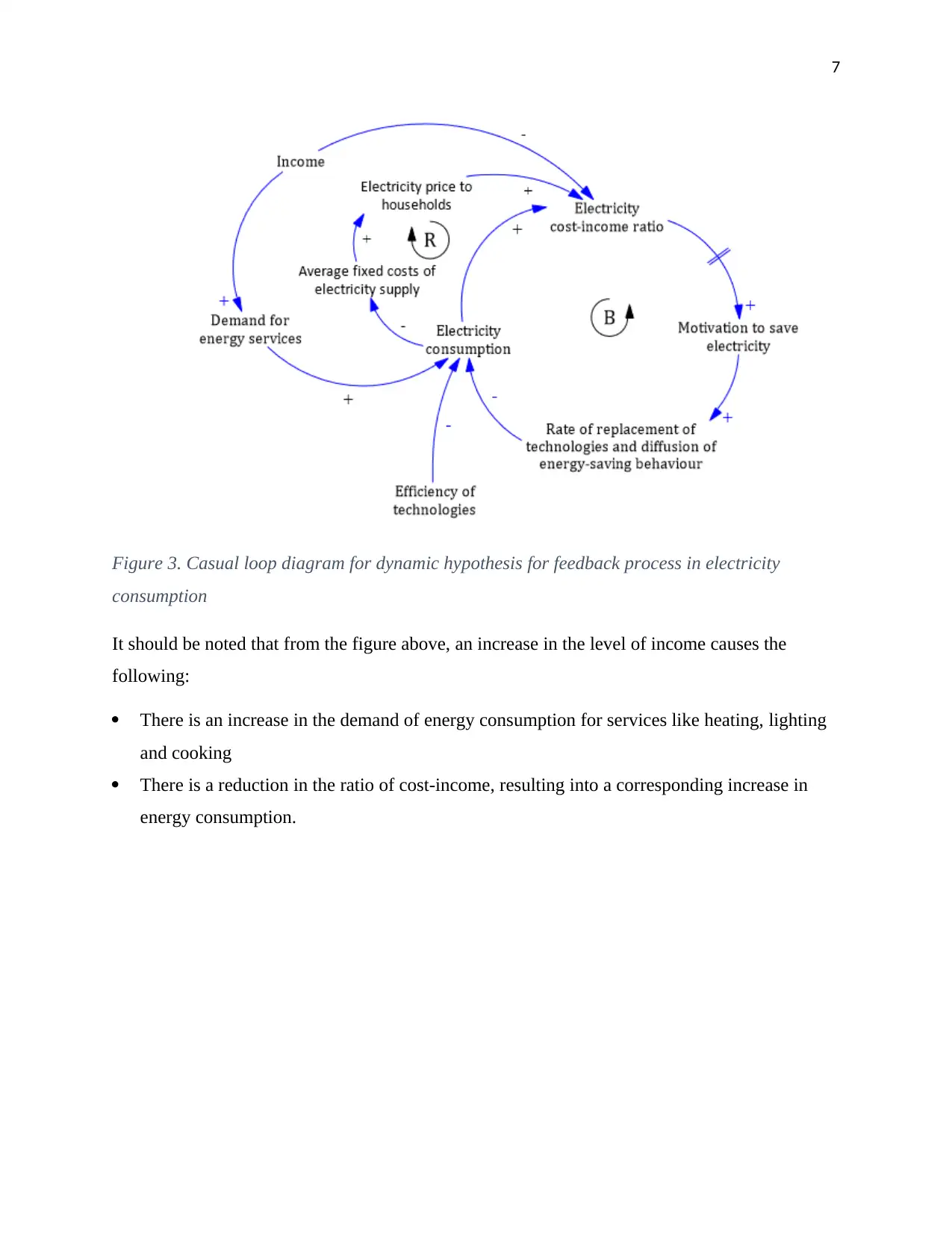
7
Figure 3. Casual loop diagram for dynamic hypothesis for feedback process in electricity
consumption
It should be noted that from the figure above, an increase in the level of income causes the
following:
There is an increase in the demand of energy consumption for services like heating, lighting
and cooking
There is a reduction in the ratio of cost-income, resulting into a corresponding increase in
energy consumption.
Figure 3. Casual loop diagram for dynamic hypothesis for feedback process in electricity
consumption
It should be noted that from the figure above, an increase in the level of income causes the
following:
There is an increase in the demand of energy consumption for services like heating, lighting
and cooking
There is a reduction in the ratio of cost-income, resulting into a corresponding increase in
energy consumption.
Paraphrase This Document
Need a fresh take? Get an instant paraphrase of this document with our AI Paraphraser
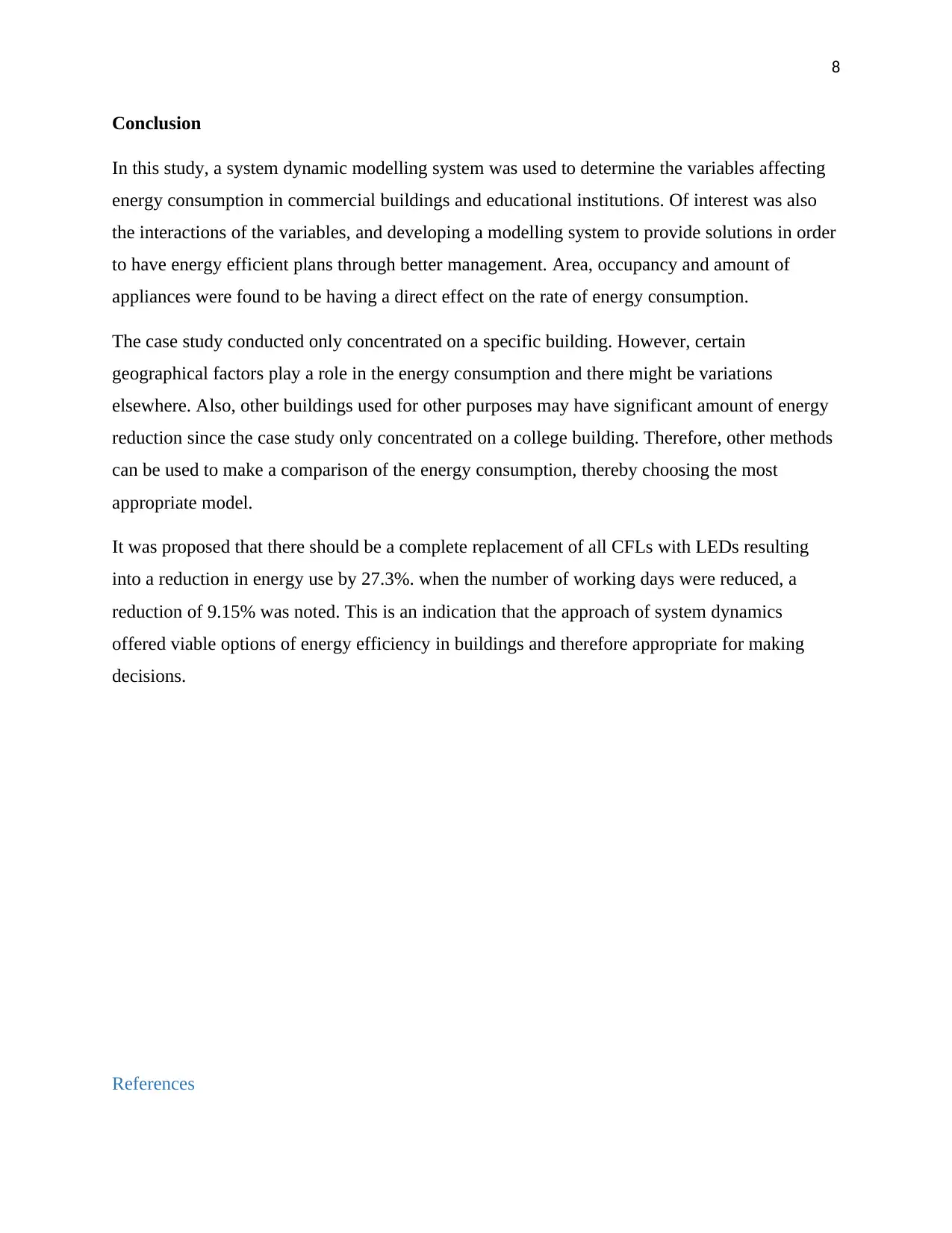
8
Conclusion
In this study, a system dynamic modelling system was used to determine the variables affecting
energy consumption in commercial buildings and educational institutions. Of interest was also
the interactions of the variables, and developing a modelling system to provide solutions in order
to have energy efficient plans through better management. Area, occupancy and amount of
appliances were found to be having a direct effect on the rate of energy consumption.
The case study conducted only concentrated on a specific building. However, certain
geographical factors play a role in the energy consumption and there might be variations
elsewhere. Also, other buildings used for other purposes may have significant amount of energy
reduction since the case study only concentrated on a college building. Therefore, other methods
can be used to make a comparison of the energy consumption, thereby choosing the most
appropriate model.
It was proposed that there should be a complete replacement of all CFLs with LEDs resulting
into a reduction in energy use by 27.3%. when the number of working days were reduced, a
reduction of 9.15% was noted. This is an indication that the approach of system dynamics
offered viable options of energy efficiency in buildings and therefore appropriate for making
decisions.
References
Conclusion
In this study, a system dynamic modelling system was used to determine the variables affecting
energy consumption in commercial buildings and educational institutions. Of interest was also
the interactions of the variables, and developing a modelling system to provide solutions in order
to have energy efficient plans through better management. Area, occupancy and amount of
appliances were found to be having a direct effect on the rate of energy consumption.
The case study conducted only concentrated on a specific building. However, certain
geographical factors play a role in the energy consumption and there might be variations
elsewhere. Also, other buildings used for other purposes may have significant amount of energy
reduction since the case study only concentrated on a college building. Therefore, other methods
can be used to make a comparison of the energy consumption, thereby choosing the most
appropriate model.
It was proposed that there should be a complete replacement of all CFLs with LEDs resulting
into a reduction in energy use by 27.3%. when the number of working days were reduced, a
reduction of 9.15% was noted. This is an indication that the approach of system dynamics
offered viable options of energy efficiency in buildings and therefore appropriate for making
decisions.
References
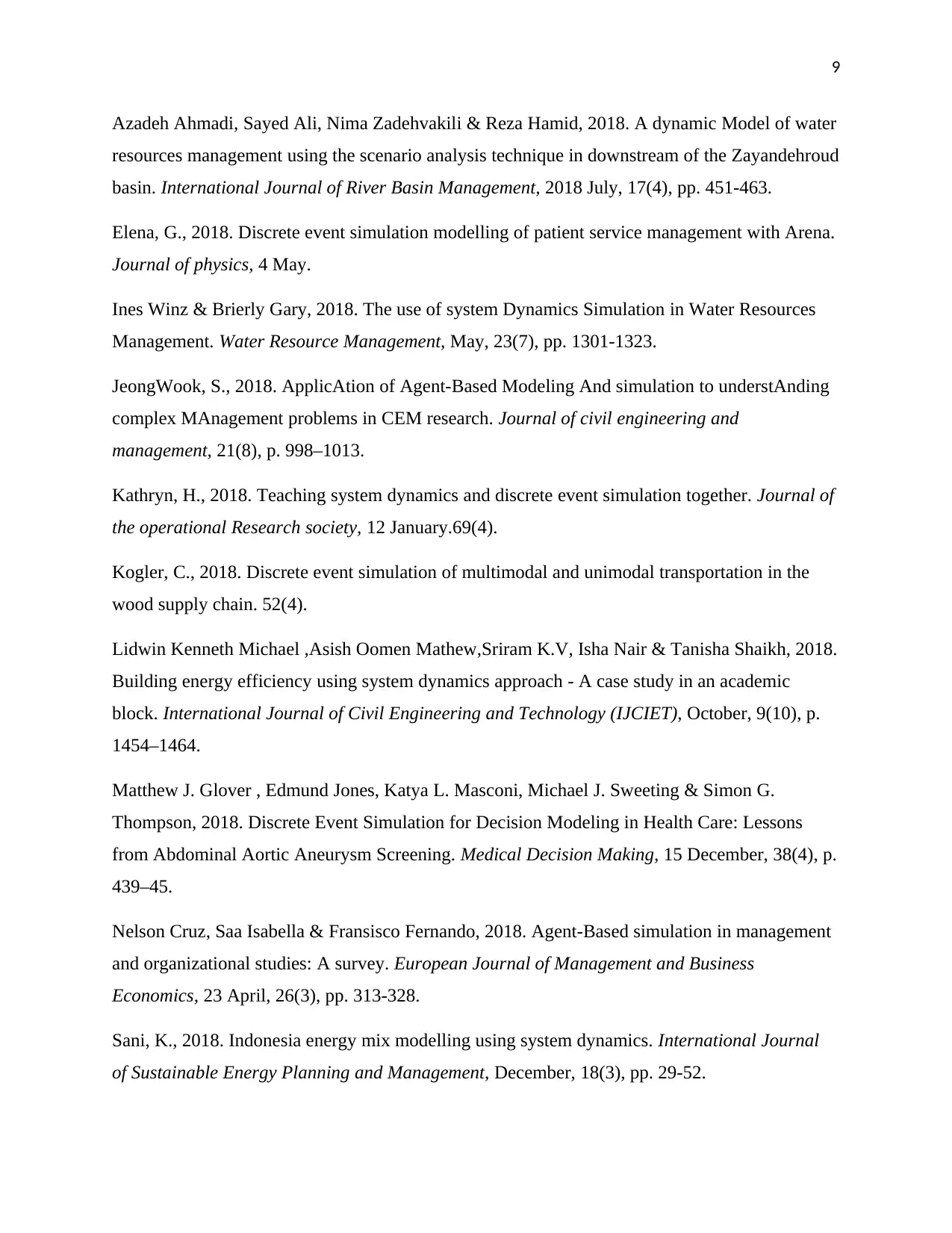
9
Azadeh Ahmadi, Sayed Ali, Nima Zadehvakili & Reza Hamid, 2018. A dynamic Model of water
resources management using the scenario analysis technique in downstream of the Zayandehroud
basin. International Journal of River Basin Management, 2018 July, 17(4), pp. 451-463.
Elena, G., 2018. Discrete event simulation modelling of patient service management with Arena.
Journal of physics, 4 May.
Ines Winz & Brierly Gary, 2018. The use of system Dynamics Simulation in Water Resources
Management. Water Resource Management, May, 23(7), pp. 1301-1323.
JeongWook, S., 2018. ApplicAtion of Agent-Based Modeling And simulation to understAnding
complex MAnagement problems in CEM research. Journal of civil engineering and
management, 21(8), p. 998–1013.
Kathryn, H., 2018. Teaching system dynamics and discrete event simulation together. Journal of
the operational Research society, 12 January.69(4).
Kogler, C., 2018. Discrete event simulation of multimodal and unimodal transportation in the
wood supply chain. 52(4).
Lidwin Kenneth Michael ,Asish Oomen Mathew,Sriram K.V, Isha Nair & Tanisha Shaikh, 2018.
Building energy efficiency using system dynamics approach - A case study in an academic
block. International Journal of Civil Engineering and Technology (IJCIET), October, 9(10), p.
1454–1464.
Matthew J. Glover , Edmund Jones, Katya L. Masconi, Michael J. Sweeting & Simon G.
Thompson, 2018. Discrete Event Simulation for Decision Modeling in Health Care: Lessons
from Abdominal Aortic Aneurysm Screening. Medical Decision Making, 15 December, 38(4), p.
439–45.
Nelson Cruz, Saa Isabella & Fransisco Fernando, 2018. Agent-Based simulation in management
and organizational studies: A survey. European Journal of Management and Business
Economics, 23 April, 26(3), pp. 313-328.
Sani, K., 2018. Indonesia energy mix modelling using system dynamics. International Journal
of Sustainable Energy Planning and Management, December, 18(3), pp. 29-52.
Azadeh Ahmadi, Sayed Ali, Nima Zadehvakili & Reza Hamid, 2018. A dynamic Model of water
resources management using the scenario analysis technique in downstream of the Zayandehroud
basin. International Journal of River Basin Management, 2018 July, 17(4), pp. 451-463.
Elena, G., 2018. Discrete event simulation modelling of patient service management with Arena.
Journal of physics, 4 May.
Ines Winz & Brierly Gary, 2018. The use of system Dynamics Simulation in Water Resources
Management. Water Resource Management, May, 23(7), pp. 1301-1323.
JeongWook, S., 2018. ApplicAtion of Agent-Based Modeling And simulation to understAnding
complex MAnagement problems in CEM research. Journal of civil engineering and
management, 21(8), p. 998–1013.
Kathryn, H., 2018. Teaching system dynamics and discrete event simulation together. Journal of
the operational Research society, 12 January.69(4).
Kogler, C., 2018. Discrete event simulation of multimodal and unimodal transportation in the
wood supply chain. 52(4).
Lidwin Kenneth Michael ,Asish Oomen Mathew,Sriram K.V, Isha Nair & Tanisha Shaikh, 2018.
Building energy efficiency using system dynamics approach - A case study in an academic
block. International Journal of Civil Engineering and Technology (IJCIET), October, 9(10), p.
1454–1464.
Matthew J. Glover , Edmund Jones, Katya L. Masconi, Michael J. Sweeting & Simon G.
Thompson, 2018. Discrete Event Simulation for Decision Modeling in Health Care: Lessons
from Abdominal Aortic Aneurysm Screening. Medical Decision Making, 15 December, 38(4), p.
439–45.
Nelson Cruz, Saa Isabella & Fransisco Fernando, 2018. Agent-Based simulation in management
and organizational studies: A survey. European Journal of Management and Business
Economics, 23 April, 26(3), pp. 313-328.
Sani, K., 2018. Indonesia energy mix modelling using system dynamics. International Journal
of Sustainable Energy Planning and Management, December, 18(3), pp. 29-52.
⊘ This is a preview!⊘
Do you want full access?
Subscribe today to unlock all pages.

Trusted by 1+ million students worldwide

10
Uldis Bariss, Gatis Bazbauers, Andra Blumberga & Dagnija Blumberga, 2018. System
Dynamics Modelling of Households' Electricity consumption and cost-income ratio: A case
study of Latvia. Environmental and Climate Technologies, January, Volume 20, pp. 36-50.
Zhang, Z., 2018. Application of discrete event simulation in healthcare: A systematic Review.
BMC Health services Research, 4 September.
Uldis Bariss, Gatis Bazbauers, Andra Blumberga & Dagnija Blumberga, 2018. System
Dynamics Modelling of Households' Electricity consumption and cost-income ratio: A case
study of Latvia. Environmental and Climate Technologies, January, Volume 20, pp. 36-50.
Zhang, Z., 2018. Application of discrete event simulation in healthcare: A systematic Review.
BMC Health services Research, 4 September.
1 out of 10
Your All-in-One AI-Powered Toolkit for Academic Success.
+13062052269
info@desklib.com
Available 24*7 on WhatsApp / Email
![[object Object]](/_next/static/media/star-bottom.7253800d.svg)
Unlock your academic potential
Copyright © 2020–2025 A2Z Services. All Rights Reserved. Developed and managed by ZUCOL.